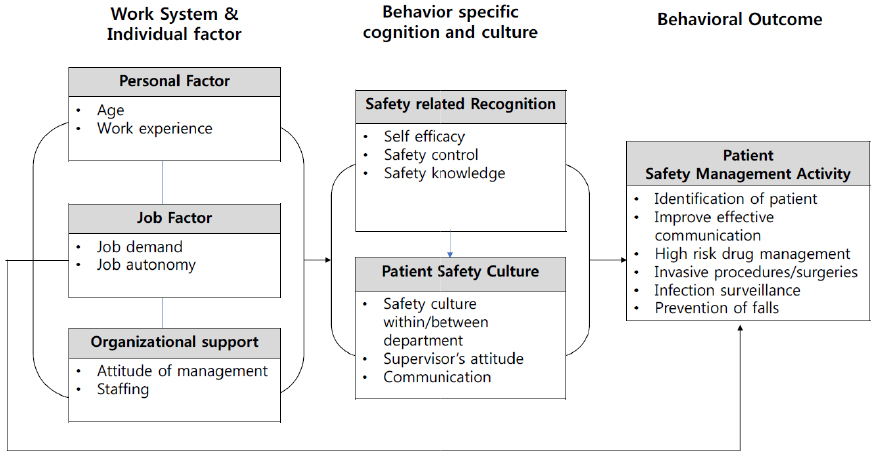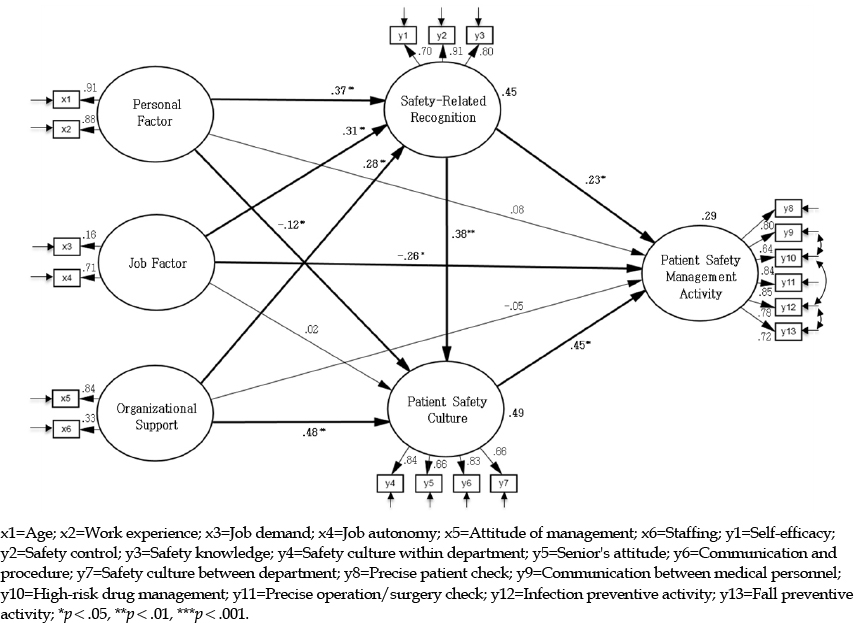J Korean Acad Nurs Adm.
2019 Mar;25(2):63-72. 10.11111/jkana.2019.25.2.63.
A Structural Equation Model of Nurses' Patient Safety Management Activities
- Affiliations
-
- 1Department of Nursing, Daejeon Institute of Science and Technology, Korea.
- 2College of Nursing, Eulji University, Korea. ksy@eulji.ac.kr
- KMID: 2442587
- DOI: http://doi.org/10.11111/jkana.2019.25.2.63
Abstract
- PURPOSE
The purpose of this study was to build and test a model outlining the factors related to nurses' patient safety management activities. The exogenous variables were personal factor, job factor and organizational support. The endogenous factors were safety-related recognition, patient safety culture and patient safety management activities.
METHODS
A survey using a structured questionnaire was conducted among 500 nurses in Korea. The collected data were analyzed using PASW Statistics 18.0 and AMOS 20.0 programs.
RESULTS
Personal factors, job factors, safety-related recognition, and patient safety culture significantly affected nurses' patient safety management activities.
CONCLUSION
These results suggest that patient safety accidents can be prevented by increasing the safety culture and safety related recognition. To improve the safety culture and safety related recognition, measures should be taken to reduce the turnover rate of career nurses and provide sufficient manpower allocation, education and policies.
Figure
Reference
-
1. Agency for Healthcare Research and Quality (US). Hospital survey on patient safety culture. AHRQ publication, vol 04-0041. Rockville, MD: U.S Department of Health and Human Services;Public Health Service, Agency for Healthcare Research and Quality;2004.2. Kim EK, Kang MA, Kim HJ. Experience and perception on patient safety culture of employees in hospitals. Journal of Korean Academy of Nursing Administration. 2007; 13(3):321–334.3. Korea Consumer Agency. A survey on the medical dispute related to safety management of hospital. Research Report. Seoul: Korea Consumer Agency;2006. 11. Report No.: 06-06.4. Nam MH, Choi SH. The cognition level on patient safety and safe nursing activities according to nurse-patient ratios. Journal of Korean Clinical Nursing Research. 2011; 17(2):138–149.5. Choi JH, Lee KM, Lee MA. Relationship between hospital nurses' perceived patient safety culture and their safety care activities. Journal of Korean Academy of Fundamentals of Nursing. 2010; 17(1):64–72.6. Lee YJ. Patient safety culture and management activities perceived by hospital nurses [master's thesis]. Daejeon: Eulji University;2011. 62.7. Kim YH, Kim SH, Kim NJ, Jung MH. Level of safety and health activities among hospital nurses. Journal of the Korean Society of Living Environmental System. 2011; 18(4):401–410.8. Park SJ, Choi E, Lee K, Chung K. A study on perception and nursing activity for patient safety of operating room nurses. Journal of the Korea Academia-Industrial Cooperation Society. 2016; 17(11):332–339. DOI: 10.5762/KAIS.2016.17.11.332.
Article9. Chung SK. A structural model of safety climate and safety compliance of hospital organization employees. Asia-Pacific Journal of Multimedia Services Convergent with Art, Humanities, and Sociology. 2017; 7(8):947–961. DOI: 10.14257/ajmahs.2017.08.84.
Article10. Pender NJ. Health promotion in nursing practice. 3rd ed. Norwalk: Appleton & Lange;1996.11. Carayon P, Hundt AS, Karsh B, Gurses AP, Alvarado CJ, Smith M, et al. Work system design for patient safety: the SEIPS model. Quality & Safety in Health Care. 2006; 15(1):i50–i58. DOI: 10.1136/qshc.2005.015842.
Article12. Kline RB. Principles and practice of structural equation modeling. 4th ed. New York: The Guilford Press;2015. p. 534.13. Chang SJ, Koh SB, Kang D, Kim SA, Kang MG, Lee CG, et al. Developing an occupational stress scale for Korean employees. Korean Journal of Occupational and Environmental Medicine. 2005; 17(4):297–317.
Article14. Jeong J, Seo YJ, Nam EW. Factors affecting patient safety management activities at nursing divisions of two university hospitals. Korean Journal of Hospital Management. 2006; 11(1):91–109.15. Kim JE, Kang MA, An KE, Sung YH. A survey of nurses' perception of patient safety related to hospital culture and reports of medical errors. Journal of Korean Clinical Nursing Research. 2007; 13(3):169–179.16. Bandura A. A Self-efficacy: The Exercise of control. New York: WH. Freeman and Company;1997. p. 604.17. Sherer M, Adams CH. Construct validation of the self-efficacy scale. Psychological Reports. 1983; 53(3):899–902. DOI: 10.2466/pr0.1983.53.3.899.
Article18. Kim SJ. Moderating effect of emotional intelligence and self-efficacy on the relationship between career commitment and career performance [master's thesis]. Gyeongsan: Yeungnam University;2007. 109.19. Anderson L. Roles of safety control and supervisory support in work safety. Paper presented at: The 19th Annual Conference of Society of Industrial/Organizational Psychology. 2004 April 1-4; Chicago.20. Probst TM, Brubaker TL. The effects of job insecurity on employee safety outcomes: cross-sectional and longitudinal explorations. Journal of Occupational Health Psychology. 2001; 6(2):139–159. DOI: 10.1037/1076-8998.6.2.139.
Article21. Neal A, Griffin MA, Hart PM. The impact of organizational climate on safety climate and individual behavior. Safety of Science. 2000; 34:99–109. DOI: 10.1016/s0925-7535(00)00008-4.
Article22. Sorra J, Nieva V, Fastman BR, Kaplan H, Schreiber G, King M. Staff attitudes about event reporting and patient safety culture in hospital transfusion services. Transfusion. 2008; 48:1934–1942. DOI: 10.1111/j.1537-2995.2008.01761.x.
Article23. Ministry of Health and Welfare (KR). Korea Health Industry Development Institute. Guidelines for hospital evaluation programme. Policy-Healthcare, vol 2006-17. Seoul: Korea Health Industry Development Institute;2006.24. Lee YM. Safety accident occurrence to perceptions of patient safety culture of hospital nurses. Journal of the Korea Academia-Industrial Cooperation Society. 2012; 13(1):117–124. DOI: 10.5762/kais.2012.13.1.117.
Article25. Lee WY. Influence of job insecurity, organizational commitment, and safety climate on safety behavior and accidents. In : Proceedings of 2005 Spring Conference of the Korean Society for Railway; 2005 May; Seoul. Korean Society for Railway;p. 32–37.26. Park YS, Lee KM. The effects of the individual and job characteristics on career commitment. Korean Journal of Local Government Studies. 2011; 15(2):35–50.27. An GY, Park NG. Empirical study based on the Neal, Griffin, and Hart's safety climate model. Journal of the Korea Safety Management & Science. 2005; 7(5):107–117.28. An GY. The relationship among safety motivation, antecedents and employee safety participation in SME. Korean Small Business Review. 2003; 25(4):155–179.
- Full Text Links
- Actions
-
Cited
- CITED
-
- Close
- Share
- Similar articles
-
- Effects of Nurses' Patient Safety Management Importance, Patient Safety Culture and Nursing Service Quality on Patient Safety Management Activities in Tertiary Hospitals
- Patient Safety Management Activities of Clinical Nurse: A Modified Theory of Planned Behavior
- Factors Influencing Military Nurses' Reporting of Patient Safety Events in South Korea: A Structural Equation Modeling Approach
- Association of Job Crafting and Perception of Patient Safety Culture with Patient Safety Management Activities among Hospital Nurses
- Nurses' Perceptions of Patient Safety Culture and Patient Safety Activities in Mental Health Hospitals



